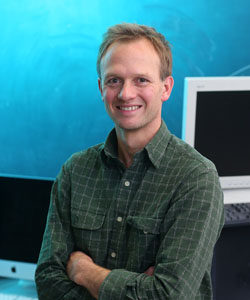It’s hard to argue against the beauty of stars. The sight of light puncturing night’s cloak has prompted philosophical musings from many thinkers. Sir John Frederick William Herschel called stars “…the land-marks of the universe.” The Lion King’s Timon, in contrast, thought they were fireflies.
 For Dal astrophysicist Scott Chapman, they’re a key that unlocks celestial history.
For Dal astrophysicist Scott Chapman, they’re a key that unlocks celestial history.
For over ten years, Dr. Chapman and an international team of astrophysicists have worked to uncover how and when the universe’s stars and galaxies took shape.
“There has long been debate over the origins of stars in galaxies even larger than our own Milky Way,” explains Dr. Chapman. “Are they born over long periods of time or in concentrated bursts?
“Before stars form there are just raw materials floating around, attracted by gravity,” he says. “Somehow these materials come together to make stars, assembled together in galaxies.”
Uncovering a “cosmic baby boom”
The team’s new study suggests the first galaxies formed in much greater abundance and much earlier in the universe’s history than previously thought. Researchers looked far into space and found galaxies experiencing a sort of “cosmic baby boom,” huge numbers of stars forming rapidly in a short period of time. They also found that, on average, these bursts of activity happened 12 billion years ago, a billion years earlier than previously thought.
The new international Atacama Large Millimeter/submillimeter Array (ALMA) Observatory telescope captured millimeter-wave light from 26 of the surveyed galaxies, which produce light at characteristic wavelengths due to large numbers of rotating carbon monoxide molecules. These wavelengths are stretched by the expansion of the universe over billions of years that it takes light to reach Earth. The team calculated the length of the light’s journey by measuring this stretch, and placed each galaxy at the right point in cosmic history: a celestial time map.
Master's student Kaja Rotermund will follow up the new paper by scrutinizing the conditions of gas turning into stars and use the galaxies as beacons to probe the nature of the elusive dark matter in the intervening space.
Mapping cosmic history
The team’s findings will contribute to piecing together galactic history and revising scientific models of galactic formation. A long and complex process, modeling involves building, testing and revising to find a model that supports the evidence that researchers see through their telescopes. A successful model can be used trace the celestial past and understand the present.
Dr. Chapman’s group has been on a roll lately with research suggesting that current models of galactic formation are incomplete. His team’s articles have graced the cover of the top journal Nature twice in the last three months. Dr. Chapman led the optical and infrared observations that built to this discovery, and his team’s identification of the foreground lenses and background galaxies, as well as measuring the distances to the lenses, were crucial to developing these more complex models.
“To construct a model, you begin with the most obvious and easy solution. If that model doesn’t fit with what’s actually happening, it must change,” says Dr. Chapman. “Current models of galaxy formation don’t explain what our group is seeing, so something more complicated must be happening.”
As Dr. Chapman continues his work, he reflects on the potential impacts of charting celestial history.
“Understanding how galaxies formed will shape thinking on everything that comes after, including our place in the universe,” he says. “That’s pretty cool.”
For more information on Dr. Chapman’s research, visit his lab’s website.

